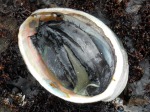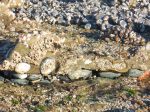Now that you have been properly introduced to my friends, you probably want to go meet them in person. I don’t blame you. Any excuse to hang out on the beach is a good excuse, in my opinion. You might have a tough time finding them though.
Once upon a time, black abalone were so common, it was difficult to walk along the rocky shoreline without inadvertently stepping on one. Millions of black abalone sunned themselves on California beaches from Mendocino County down to Baja, where they enjoyed limes in their Corona’s and salt with their margaritas.
[Cue creepy, evil sounding music] Then withering syndrome hit the species. Strong and healthy growing boys and girls became anorexic and it wasn’t due to some fad in a magazine telling them that skinny was cool. Withering syndrome is a bacterial disease that invades the digestive gland and prevents the absorption of materials, so although they ate and ate and ate, no nutrients were absorbed, and they were forced to metabolize their foot muscle to survive. That continued until they were too weak to hold onto rocks, and died shortly after. The beach party had ended.
My advisor, Dr. Glenn VanBlaricom, caught the whole story in data. He began counting and measuring black abalone around San Nicolas Island in the late 1970s. I enjoy teasing him, reminding VanBlaricom that his project is older than I am, but the timeline in which he has studied black abalone has been an invaluable tool. He documented black abalone numbers in the 1970s and 1980s when they were a strong, stable community dominating the shoreline, captured the sudden and sharp decline beginning in 1992 when the disease first hit San Nicolas Island, the following years when individual abalone were rare and far between, and now the most exciting part…the recovery!
Beginning around 2001, abalone numbers started to grow in isolated areas around the island. In just the last year, almost all locations that VanBlaricom has monitored annually for the past 33 years have increased by 30 to 50%, but not all. This leads to my favorite part of research: the questions!
Why are abalone populations only recovering in some locations, but not all? Why are they not recovering evenly, but instead at different rates? What is so special about San Nicolas Island, and why aren’t we seeing the same recovery patterns in other Channel Islands and on the mainland?
And more! There are so many more questions!
Next up: the project…



Very informative, yet personable and your great personality is really coming through. I really enjoyed reading your blog. Good luck with the research, hopefully what is causing them to stick their foot in their mouth :).